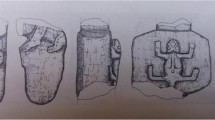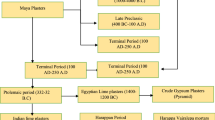Abstract
Sanliurfa limestones have been used as building materials from antiquity to current day (e.g., Gobeklitepe temple B.P. 14,000, Bazda underground quarries B.P. 3000, Harran castle B.P. 3000, etc.). These antique structures are listed within the United Nations Educational, Scientific and Cultural Organization (UNESCO)’s World Heritage List. However, the stones were used in these structures without any protection, and atmospheric conditions (precipitation, acid rain, temperature changes, etc.) cause damage to these stones over time, such as strength loss, abrasion, and discoloring. The damage can lead to the collapse of precious historical structures, or may require costly restoration. In this study, Sanliurfa limestone was investigated with respect to conservation using polish insulation (polysiloxane, lithium silicate, and varnish), appearance performance by polishing, and potential usage in the marble industry. The results revealed that conservatives could maintain up to 92 % of the unconfined compressive strength (UCS) of the natural stone and reduced acid abrasion to 0.5 % of the original weight. The stone gained a bright appearance after polishing, especially by lithium silicate. Thus, it can be stated that it is possible to recover or prolong the lifetime of the monuments that were constructed using Sanliurfa limestone, and this limestone may have great industrial potential as marble stone.














Similar content being viewed by others
References
Agan C (2011) Investigation into the usage of Sanliurfa limestones in Turkey as underground storage cavern with regard to some engineering properties. Int J Phy Sci 6(33):7629–7637
Agan C, Yesilnacar MI, Genis M, Kulaksiz S, Ulusay R, Aydan O, Yucel MD (2013) A preliminary geoengineering assessment of Bazda antique underground quarries in Şanlıurfa, Turkey. In: The Proceeding book of the ISRM International Symposium: Rock Mechanics for Resources, Energy, and Environment (EUROCK 2013), Wroclaw, Poland, pp 93–98
Akcansa (2012) Beton teknik notlari 2 (in Turkish), Heidelbergcement-SA, http://www.akcansa.com.tr
ASTM C170 (1999) Standard Test Method for Compressive Strength of Dimension Stone. ASTM International, USA
ASTM C97 (1996) Standard Test Methods for Absorption and Bulk Specific Gravity of Dimension Stone. ASTM International, USA
ASTM D5312 (2013) Standard Test Method for Evaluation of Durability of Rock for Erosion Control Under Freezing and Thawing Conditions. ASTM International, USA
Azzoni A, Bailo F, Rondena E, Zanietti A (1996) Assessment of texture coefficient for different rock types and correlation with uniaxial compressive strength and rock weathering. Rock Mech Rock Eng 29(1):39–46
Bednarik M, Moshammer B, Heinrich M, Holzer R, Laho M, Uhlir C, Unterwurzacher M, Julia Rabeder (2014) Engineering geological properties of Leitha Limestone from historical quarries in Burgenland and Styria, Austria. Eng Geol 176:66–78
Benavente D, Garcia del Cura MA, Fort R, Ordonez S (2004) Durability estimation of porous building stones from pore structure and strength. Eng Geol 74:113–127
Bernd F, Kurt H (2005) Kartierung und Bewertung von Verwitterungsschaden an Natursteinbauwerken (in German). Zeitschrift Deutschen Gesellschaft Geowissenschaften 21:7–24
Blows JF, Carey PJ, Poole AB (2003) Preliminary investigations into Caen Stone in the UK; its use weathering and comparison with repconvection stone. Build Environ 38:1143–1149
Brotons V, Tomas R, Ivorra S, Alarcon JC (2013) Temperature influence on the physical and mechanical properties of a porous rock: San Julian’s calcarenite. Eng Geol 167:117–127
Canakci H, Demirboga R, Karakoc MB, Sirin O (2007) Thermal conductivity of limestone from Gaziantep (Turkey). Build Environ 42:1777–1782
Cardell C, Delalieux F, Roumpopoulos K, Moropoulou A, Auger F, Van Grieken R (2003) Salt-induced decay in calcareous stone monuments and buildings in a marine environment in SW France. Constr Build Mater 17:165–179
Devos A, Sosson C, Lejeune O, Fronteau G (2005) Role des contextes geomorphologique et geologique dans l’abandon des carrieres de pierre du Lutetien autour de Reims (in French). In: International symposium “Pierres du patrimoine europeen: Economie de la pierre de l’Antiquite a la fin du XVIIIe siecle en Europe”, 18–21 Oct 2005, Chateau-Thierry, p 64
Dreesen R, Dusar M (2004) Historical building stones in the province of Limburg (NE Belgium): role of petrography in provenance and durability assessment. Mater Charact 53:273–287
Fronteau G, Moreau C, Thomachot-Schneider C, Barbin V (2010) Variability of some Lutetian building stones from the Paris Basin, from characterisation to conservation. Eng Geol 115:158–166
Gomez-Heras M, McCabe S, Smith BJ, Fort R (2009) Impacts of fire on stone-built heritage. J Archit Conserv 15(2):47–48
Kaufmann O, Quinif Y (1999) Cover-collapse sinkholes in the “Tournaisis” area, southern Belgium. Eng Geol 52:15–22
Kulaksiz S, Agan C (2009) Urfa (Harran) Bazda ancient underground marble quarying. In: The Proceeding book of the 3rd Balkan Mining Congress (BALKANMINE 2009), ISBN: 978-9944-89-782-2, Izmir, Turkey, pp 683–689
Kulaksiz S, Aydan O (2010) Characteristics of ancient underground quarries of Turkey and Egypt and their comparison. 22nd World Mining Congress, Istanbul, pp 607–614
Lam dos Santos JP, Rosa LG, Amaral PM (2011) Temperature effects on mechanical behavior of engineered stones. Constr Build Mater 25:171–174
Neville AM (2000) Properties of Concrete, 4th edn. Longman Scientific and Technical, New York/USA 27
Nicholson DT (2000) Pore properties as indicators of breakdown mechanisms in experimentally weathered limestones. Earth Surf Proc Land 26:819–838
Ozcelik Y, Ozguven A (2014) Water absorption and drying features of different natural building stones. Constr Build Mater 63:257–270
Ozguven A, Ozcelik Y (2013) Investigation of some property changes of natural building stones exposed to fire and high heat. Constr Build Mater 38:813–821
Ozguven A, Ozcelik Y (2014) Effects of high temperature on physico-mechanical properties of Turkish natural building stones. Eng Geol 183:127–136
Roels S, Carmeliet J, Hens H (2000) Microscopic analysis of imbibition processes in oolitic limestone. Geophys Res Lett 27:3533–3536
Sariisik A (1998) Kalsiyum karbonat kokenli mermerlerin cevre etkilesimi ile fiziko mekanik ozelliklerindeki degisim karakteristiklikleri (in Turkish). Ph.D. Thesis, Suleyman Demirel Universitesi, Maden Muhendisligi, Isparta, p 11
Sariisik A, Sariisik G (2011) Environmental interaction properties of marbles used in the restoration of historical monuments (Dalyan-Kaunos). Ekoloji 79:12–19
Sariisik A, Senturk A, Sariisik G (2005) Burdur yoresi mermerlerin teknik ve ekonomik yonuyle irdelenmesi (in Turkish). 1. Burdur Sempozyumu, 16–19 Nov, Burdur, pp 857–869
Sharma PK, Khandelwal M, Singh TN (2007) Variation on physico-mechanical properties of Kota stone under different watery environments. Build Environ 42:4117–4123
Singh TN, Singh SK, Mishra A, Singh PK, Singh VK (1999) Effect of acidic water on physico-mechanical behaviour of rock. Indian J Eng Mater Sci 6:66–72
Striegel MF, Guin EB, Hallett K, Sandoval D, Swingle R, Knox K, Best F, Fornea S (2003) Convection pollution, coatings, and cultural resources. Prog Org Coat 58:281–288
TS 699 (1987) Tabii yapi taslari, muayene ve deney metotlari - Methods of Testing for Natural Building Stones (in Turkish). Turk Standartlari Enstitusu, Ankara
Turgut P, Yesilnacar MI, Bulut H (2008) Physico-thermal and mechanical properties of Sanliurfa limestone, Turkey. Bull Eng Geol Environ 67:485–490
Winkler EM (1973) Stone: Properties, durability in man’s environment. Springer-Verlag, Berlin 313
Yesilnacar MI, Cetin H (2005) Site selection for hazardous wastes: a case study from the GAP area, Turkey. Eng Geol 81(4):371–388
Zezza U (1990) Physical—mechanical properties of quarry and building stones. In: Veniale F, Zezza U (ed) Analytical methodologies of damage stones, Pavia, pp 1–20
Acknowledgments
HUBAK (Scientific Research Projects Office of Harran University) funded this study (Project No: 1149). The support of the HUBAK and the assistance provided by Selahattin Yanmaz (Yanmaz Karo Ltd.Sti) are greatly appreciated. The author would also like to give thanks to the Editor and the Reviewers for their valuable comments and contributions to the article.
Author information
Authors and Affiliations
Corresponding author
Rights and permissions
About this article
Cite this article
Agan, C. A preliminary study on the conservation and polishing performance of Sanliurfa limestones as a traditional building material. Bull Eng Geol Environ 75, 13–25 (2016). https://doi.org/10.1007/s10064-015-0729-6
Received:
Accepted:
Published:
Issue Date:
DOI: https://doi.org/10.1007/s10064-015-0729-6




